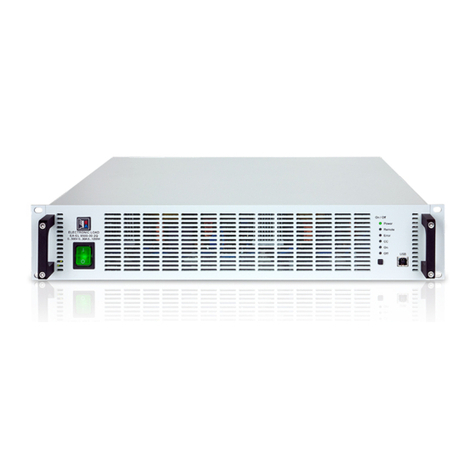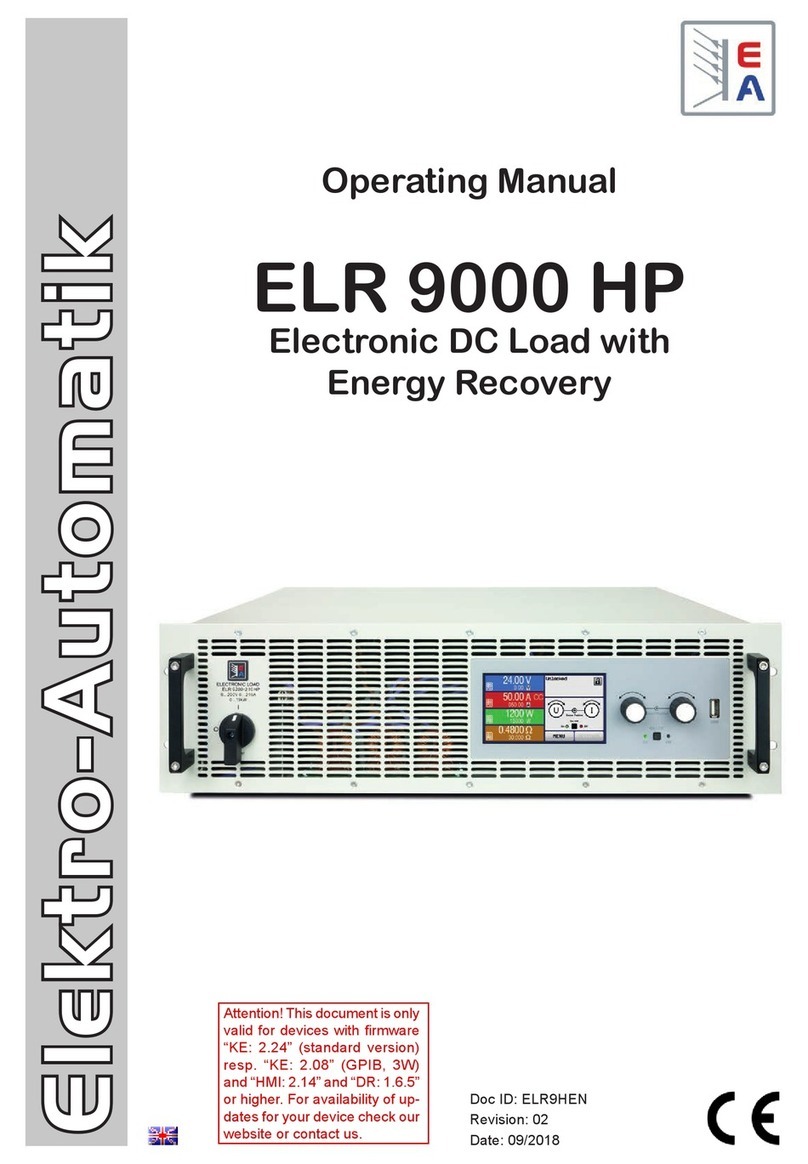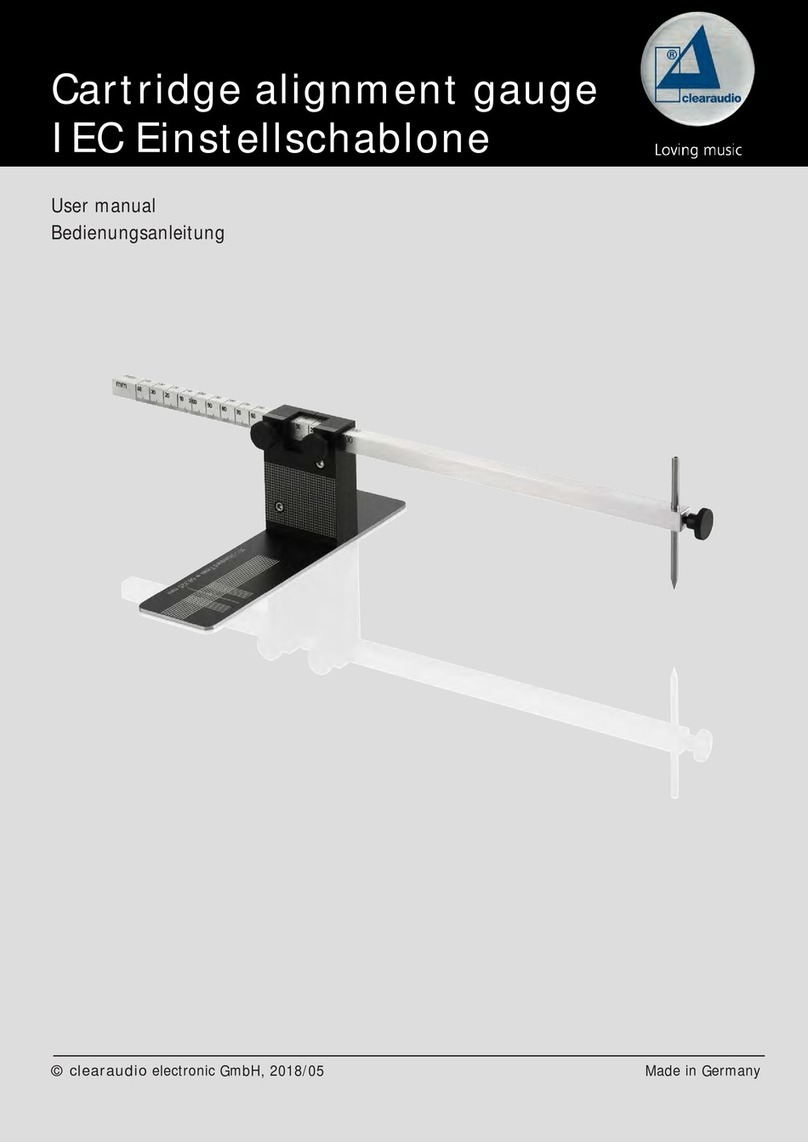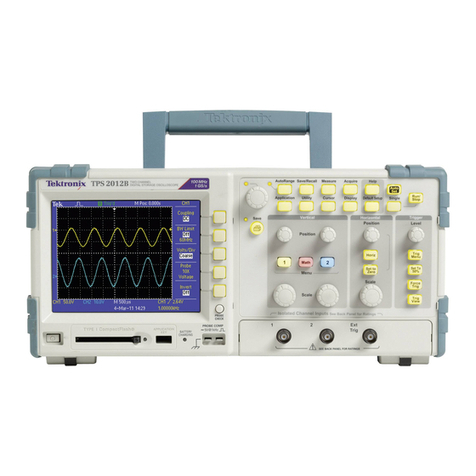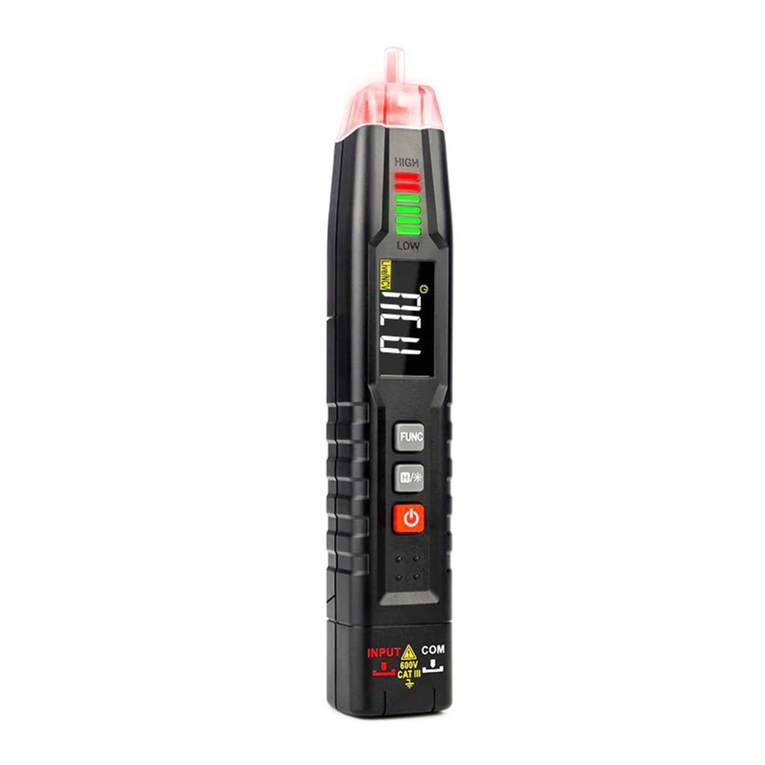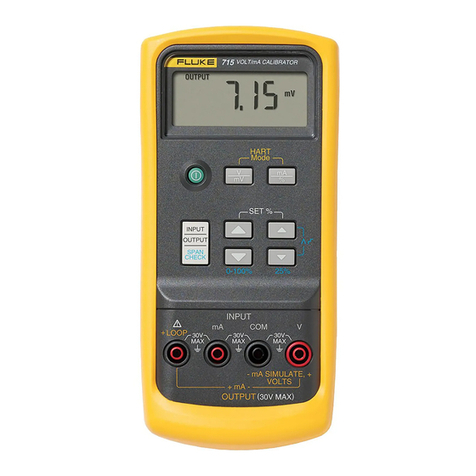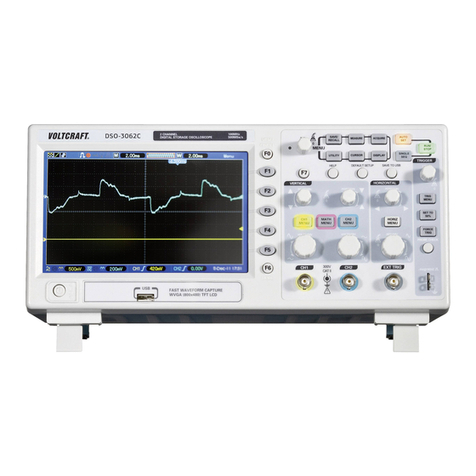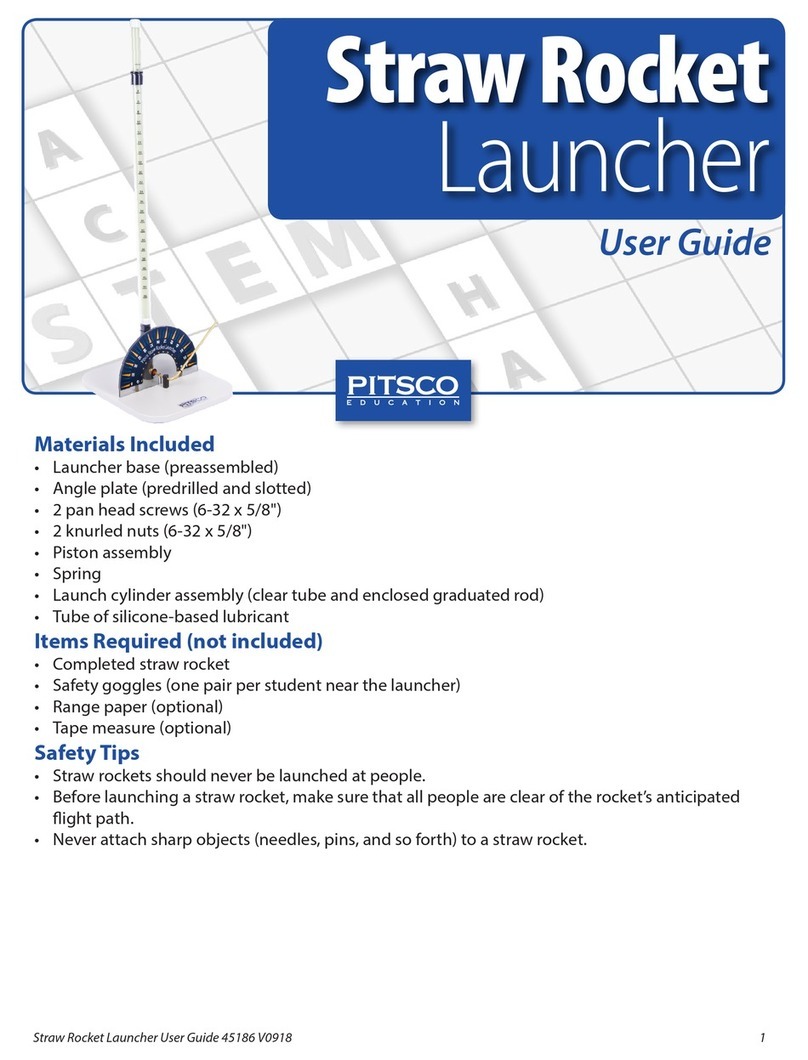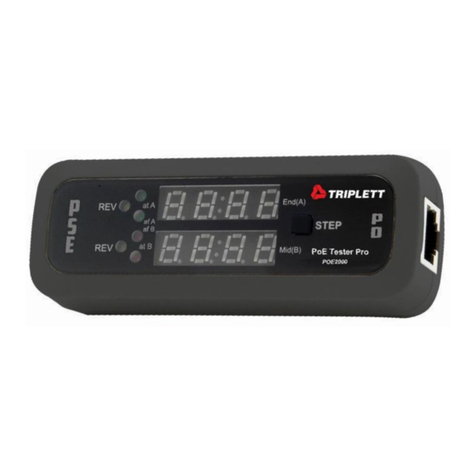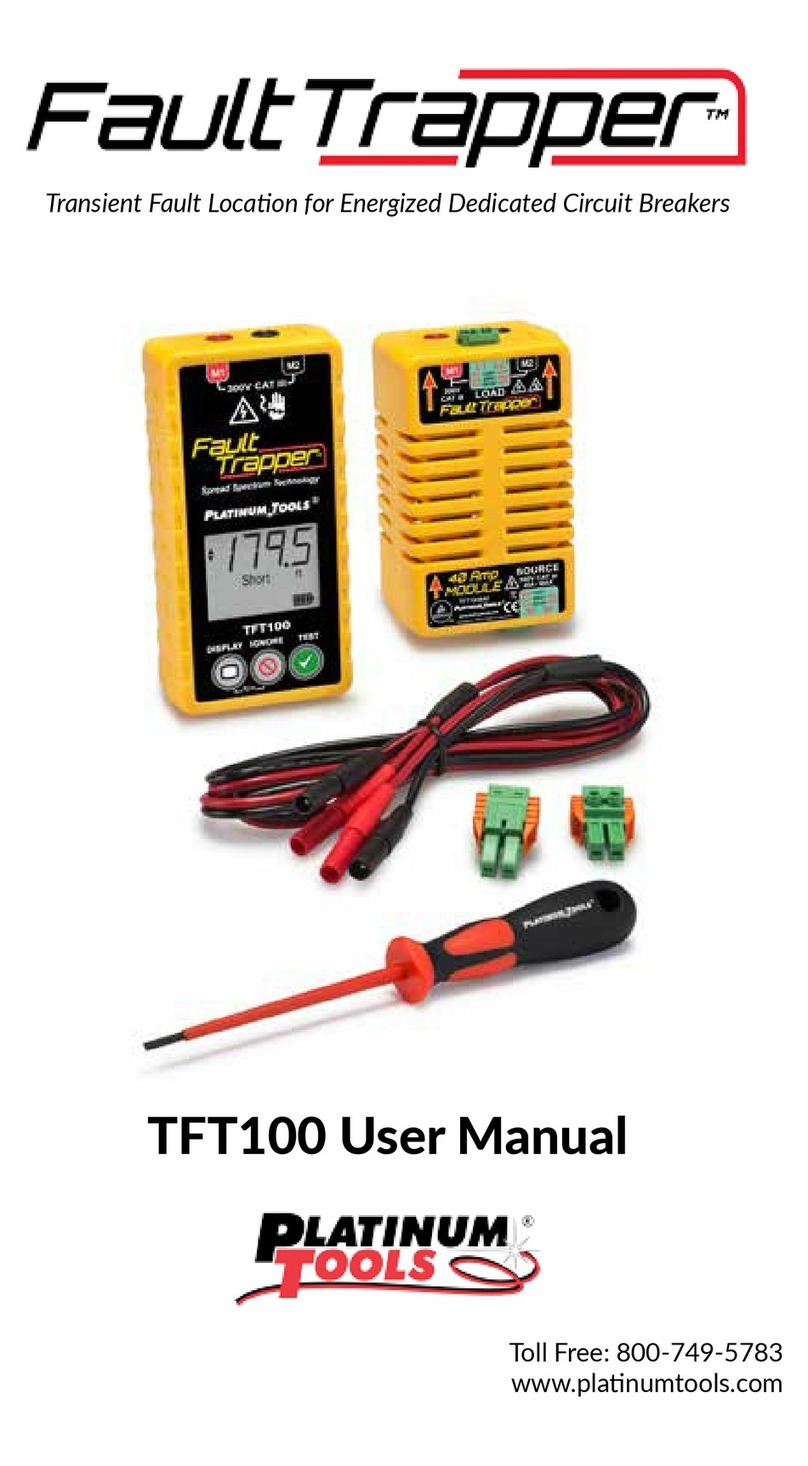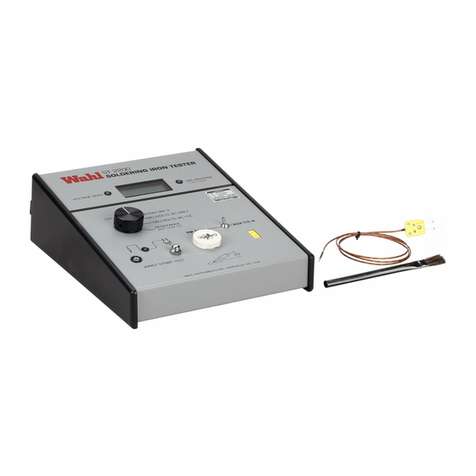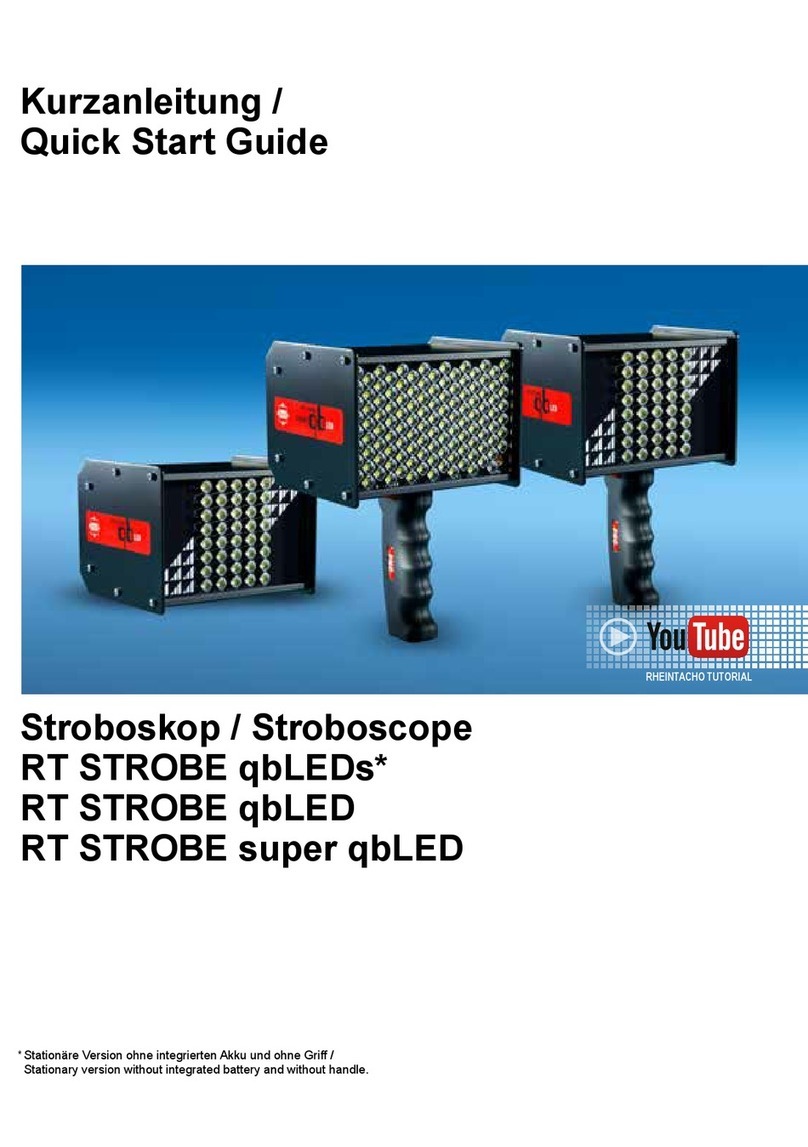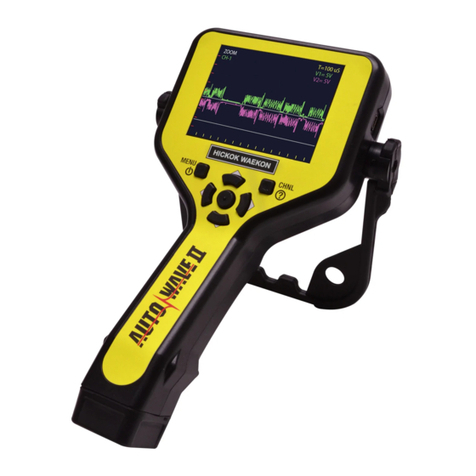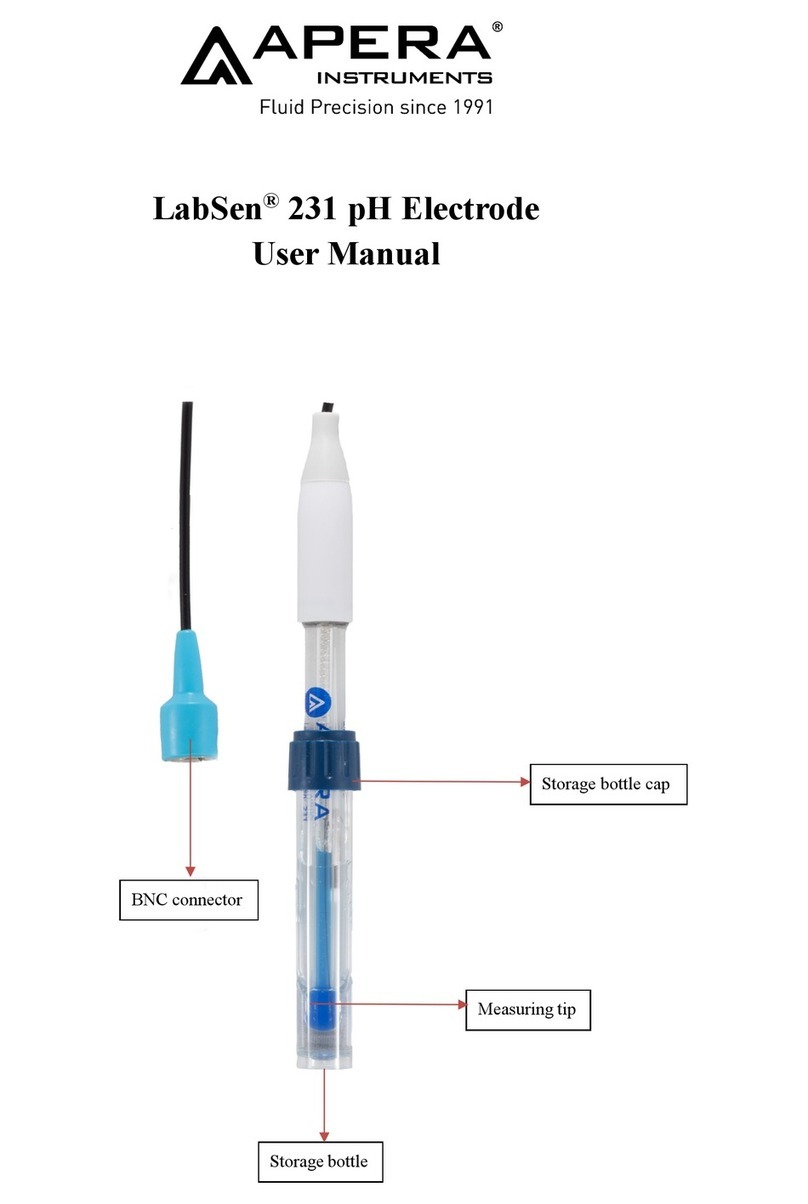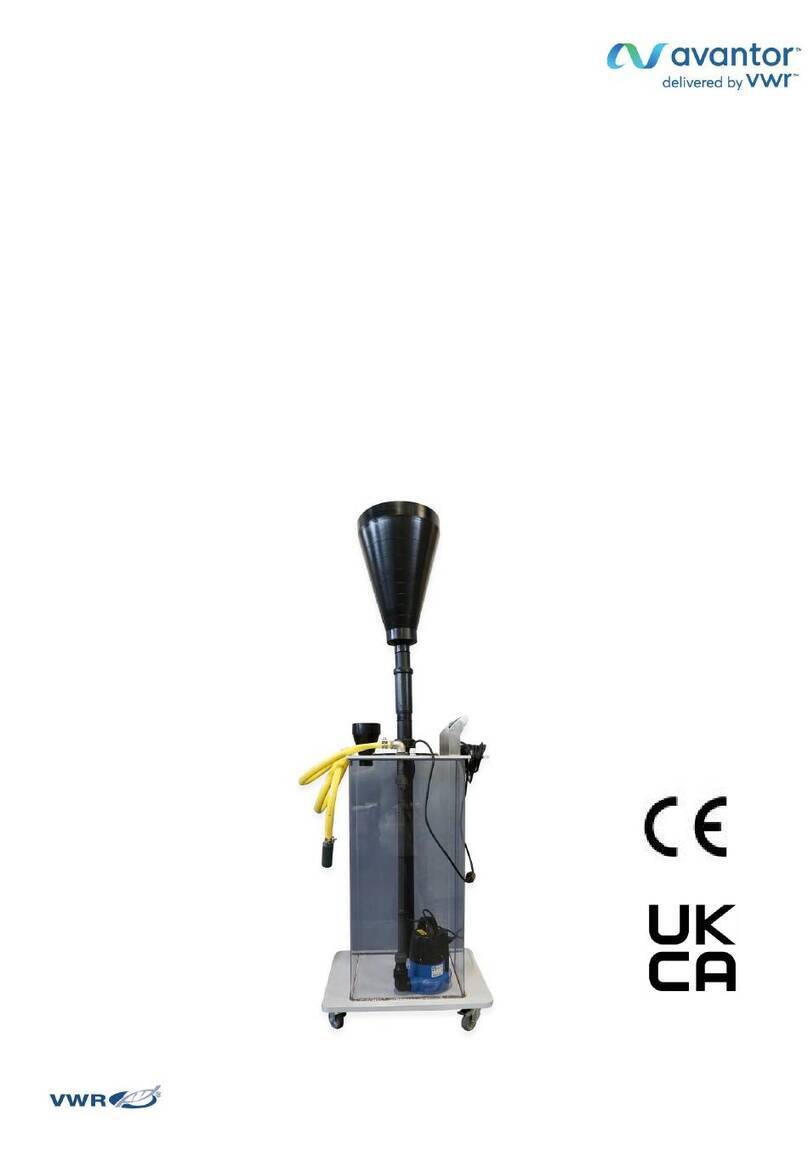Elektro-Automatik ELR 9000 User manual

Elektro-Automatik
Operating Manual
Attention! This document is only
valid for devices with rmware
“KE: 2.25” (standard version)
resp. “KE: 2.08” (GPIB, 3W)
and “HMI: 2.15” and “DR: 1.6.5”
or higher. For availability of up-
dates for your device check our
website or contact us.
Doc ID: ELR9TEN
Revision: 07
Date: 11/2018
ELR 9000
Electronic DC Load with
Energy Recovery


Page 3
EA Elektro-Automatik GmbH
Helmholtzstr. 31-37 • 41747 Viersen
Germany
Fon: +49 2162 / 3785-0
Fax: +49 2162 / 16230
www.elektroautomatik.de
ELR 9000 Series
TABLE OF CONTENTS
1GENERAL
1.1 About this document......................................5
1.1.1 Retention and use..........................................5
1.1.2 Copyright........................................................5
1.1.3 Validity ............................................................5
1.1.4 Symbols and warnings ..................................5
1.2 Warranty.........................................................5
1.3 Limit of liability ................................................5
1.4 Disposal of equipment ...................................6
1.5 Product key ....................................................6
1.6 Intended usage ..............................................6
1.7 Safety .............................................................7
1.7.1 Safety notices.................................................7
1.7.2 Responsibility of the user...............................7
1.7.3 Responsibility of the operator .......................8
1.7.4 User requirements .........................................8
1.7.5 Alarm signals..................................................9
1.8 Technical data ................................................9
1.8.1 Approved operating conditions......................9
1.8.2 General technical data...................................9
1.8.3 Specic technical data (230 V models).......10
1.8.4 Specic technical data (208 V models).......16
1.8.5 Views............................................................22
1.8.6 Control elements..........................................25
1.9 Construction and function............................26
1.9.1 General description......................................26
1.9.2 Block diagram ..............................................26
1.9.3 Scope of delivery .........................................27
1.9.4 Accessories..................................................27
1.9.5 Options .........................................................27
1.9.6 The control panel (HMI)...............................28
1.9.7 USB port (rear side).....................................31
1.9.8 Interface module slot ...................................31
1.9.9 Analog interface ...........................................31
1.9.10 Share connector...........................................32
1.9.11 Sense connector (remote sensing) .............32
1.9.12 Master-Slave bus.........................................32
1.9.13 GPIB port (optional) .....................................32
2INSTALLATION &
COMMISSIONING
2.1 Transport and storage .................................33
2.1.1 Transport ......................................................33
2.1.2 Packaging ....................................................33
2.1.3 Storage.........................................................33
2.2 Unpacking and visual check........................33
2.3 Installation ....................................................33
2.3.1 Safety procedures before installation and
use................................................................33
2.3.2 Preparation...................................................34
2.3.3 Installing the device .....................................34
2.3.4 Mains connection (AC) ................................35
2.3.5 Connection to DC sources ..........................38
2.3.6 Grounding of the DC input...........................39
2.3.7 Connection of remote sensing ....................39
2.3.8 Connecting the “Share” bus ........................40
2.3.9 Installation of an interface module...............40
2.3.10 Connecting the analog interface .................41
2.3.11 Connecting the USB port (rear side)...........41
2.3.12 Initial commission.........................................41
2.3.13 Commission after a rmware update or a
long period of non use .................................41
3OPERATION AND APPLICATION
3.1 Personal safety ............................................42
3.2 Operating modes .........................................42
3.2.1 Voltage regulation / Constant voltage .........42
3.2.2 Current regulation / constant current / current
limitation .......................................................43
3.2.3 Resistance regulation / constant resistance43
3.2.4 Power regulation / constant power / power
limitation .......................................................43
3.2.5 Dynamic characteristics and stability crite-
ria..................................................................43
3.3 Alarm conditions ..........................................44
3.3.1 Power Fail ...................................................44
3.3.2 Overtemperature..........................................44
3.3.3 Overvoltage..................................................44
3.3.4 Overcurrent ..................................................44
3.3.5 Overpower....................................................44
3.4 Manual operation .........................................45
3.4.1 Powering the device ....................................45
3.4.2 Switching the device o...............................45
3.4.3 Conguration via MENU..............................45
3.4.4 Adjustment limits..........................................55
3.4.5 Changing the operating mode.....................55
3.4.6 Manual adjustment of set values.................56
3.4.7 Switching the main screen view ..................56
3.4.8 The meter bars.............................................57
3.4.9 Switching the DC input on or o..................57
3.4.10 Recording to USB stick (logging) ................58
3.5 Remote control.............................................59
3.5.1 General.........................................................59
3.5.2 Controls locations ........................................59
3.5.3 Remote control via a digital interface ..........59
3.5.4 Remote control via the analog interface
(AI)................................................................60
3.6 Alarms and monitoring.................................64
3.6.1 Denition of terms ........................................64
3.6.2 Device alarm and event handling................64
3.7 Control panel (HMI) lock..............................67
3.8 Limits lock.....................................................67
3.9 Loading and saving a user prole ...............68
3.10 The function generator.................................69

Page 4
EA Elektro-Automatik GmbH
Helmholtzstr. 31-37 • 41747 Viersen
Germany
Fon: +49 2162 / 3785-0
Fax: +49 2162 / 16230
www.elektroautomatik.de
ELR 9000 Series
3.10.1 Introduction...................................................69
3.10.2 General.........................................................69
3.10.3 Method of operation.....................................70
3.10.4 Manual operation .........................................70
3.10.5 Sine wave function.......................................71
3.10.6 Triangular function .......................................72
3.10.7 Rectangular function....................................72
3.10.8 Trapezoidal function.....................................73
3.10.9 DIN 40839 function ......................................73
3.10.10 Arbitrary function..........................................74
3.10.11 Ramp function..............................................78
3.10.12 UI and IU table functions (XY table)............78
3.10.13 Battery test function .....................................80
3.10.14 MPP tracking function..................................82
3.10.15 Remote control of the function generator....85
3.11 Other applications........................................86
3.11.1 Parallel operation in master-slave (MS)......86
3.11.2 Series connection ........................................89
3.11.3 Two quadrants operation (2QO)..................90
4SERVICE AND MAINTENANCE
4.1 Maintenance / cleaning................................92
4.2 Fault nding / diagnosis / repair...................92
4.2.1 Firmware updates ........................................92
4.3 Calibration ....................................................93
4.3.1 Preface .........................................................93
4.3.2 Preparation...................................................93
4.3.3 Calibration procedure ..................................93
5CONTACT AND SUPPORT
5.1 Repairs .........................................................95
5.2 Contact options ............................................95

Page 5
EA Elektro-Automatik GmbH
Helmholtzstr. 31-37 • 41747 Viersen
Germany
Fon: +49 2162 / 3785-0
Fax: +49 2162 / 16230
www.elektroautomatik.de
ELR 9000 Series
1. General
1.1 About this document
1.1.1 Retention and use
This document is to be kept in the vicinity of the equipment for future reference and explanation of the operation of
the device. This document is to be delivered and kept with the equipment in case of change of location and/or user.
1.1.2 Copyright
Reprinting, copying, also partially, usage for other purposes as foreseen of this manual are forbidden and breach
may lead to legal process.
1.1.3 Validity
This manual is valid for the following devices with TFT display panel, including derived variants.
Model Article nr. Model Article nr. Model Article nr.
ELR 9080-170 33 200 401 ELR 9250-140 33 200 406 ELR 9250-210 33 200 411
ELR 9250-70 33 200 402 ELR 9500-60 33 200 407 ELR 9500-90 33 200 412
ELR 9500-30 33 200 403 ELR 9750-44 33 200 408 ELR 9750-66 33 200 413
ELR 9750-22 33 200 404 ELR 91000-30 33 200 409 ELR 91500-30 33 200 414
ELR 9080-340 33 200 405 ELR 9080-510 33 200 410
1.1.4 Symbols and warnings
Warning and safety notices as well as general notices in this document are shown in a box with a symbol as follows:
Symbol for a life threatening danger
Symbol for general safety notices (instructions and damage protection bans)
Symbol for general notices
1.2 Warranty
EA Elektro-Automatik guarantees the functional competence of the device within the stated performance param-
eters. The warranty period begins with the delivery of free from defects equipment.
Terms of guarantee are included in the general terms and conditions of EA Elektro-Automatik.
1.3 Limit of liability
All statements and instructions in this manual are based on current norms and regulations, up-to-date technology
and our long term knowledge and experience. EA Elektro-Automatik accepts no liability for losses due to:
• Usage for purposes other than dened
• Use by untrained personnel
• Rebuilding by the customer
• Technical changes
• Use of non authorized spare parts
The actual delivered device(s) may dier from the explanations and diagrams given here due to latest technical
changes or due to customized models with the inclusion of additionally ordered options.

Page 6
EA Elektro-Automatik GmbH
Helmholtzstr. 31-37 • 41747 Viersen
Germany
Fon: +49 2162 / 3785-0
Fax: +49 2162 / 16230
www.elektroautomatik.de
ELR 9000 Series
1.4 Disposal of equipment
A piece of equipment which is intended for disposal must, according to European laws and regulations (ElektroG,
WEEE) be returned to EA Elektro-Automatik for scrapping, unless the person operating the piece of equipment or
another, delegated person is conducting the disposal. Our equipment falls under these regulations and is accord-
ingly marked with the following symbol:
1.5 Product key
Decoding of the product description on the label, using an example:
ELR 9 1500 - 30 xx zzz
Field for identication of installed options and/or special models
3W = Option “Three-way interface” (GPIB/USB/Analog) installed
S01...S0x = Special models with or without options
Construction (not printed everywhere)
3U = 19” enclosure with 3 units of height
Maximum current of the device in Ampere
Maximum voltage of the device in Volt
Series: 9= Series 9000 etc.
Type identication:
ELR = Electronic Load with Recovery
1.6 Intended usage
The equipment is intended to be used, if a power supply or battery charger, only as a variable voltage and current
source, or, if an electronic load, only as a variable current sink.
Typical application for a power supply is DC supply to any relevant user, for a battery charger the charging of vari-
ous battery types and for electronic loads the replacement of Ohm resistance by an adjustable DC current sink in
order to load relevant voltage and current sources of any type.
• Claims of any sort due to damage caused by non-intended usage will not be accepted.
• All damage caused by non-intended usage is solely the responsibility of the operator.

Page 7
EA Elektro-Automatik GmbH
Helmholtzstr. 31-37 • 41747 Viersen
Germany
Fon: +49 2162 / 3785-0
Fax: +49 2162 / 16230
www.elektroautomatik.de
ELR 9000 Series
1.7 Safety
1.7.1 Safety notices
Mortal danger - Hazardous voltage
• Electrical equipment operation means that some parts will be under dangerous voltage.
Therefore all parts under voltage must be covered!
• All work on connections must be carried out under zero voltage (input not connected to
voltage sources) and may only be performed by qualied and informed persons. Improper
actions can cause fatal injury as well as serious material damage.
• Never touch cables or connectors directly after unplugging from mains supply as the
danger of electric shock remains.
• This electronic load device uses an inverter and in case of a failure the intermediate
circuit voltage can be present on the DC input, even if there is no voltage source con-
nected - it is recommended to never touch the metal parts of the DC input terminals
with bare hands! There also can be dangerous potential between negative DC input to
PE or positive DC input to PE due to charged X capacitors which either discharge very
slowly or not at all!
• The equipment must only be used as intended
• The equipment is only approved for use within the connection limits stated on the product label.
• Do not insert any object, particularly metallic, through the ventilator slots
• Avoid any use of liquids near the equipment. Protect the device from wet, damp and conden-
sation.
• For power supplies and battery chargers: do not connect users, particularly low resistance, to
devices under power; sparking may occur which can cause burns as well as damage to the
equipment and to the user.
• For electronic loads: do not connect power sources to equipment under power, sparking may
occur which can cause burns as well as damage to the equipment and to the source.
• ESD regulations must be applied when plugging interface cards or modules into the relative slot
• Interface cards or modules may only be attached or removed after the device is switched o.
It is not necessary to open the device.
• Do not connect external power sources with reversed polarity to DC input or outputs! The
equipment will be damaged.
• For power supply devices: avoid where possible connecting external power sources to the DC
output, and never those that can generate a higher voltage than the nominal voltage of the device.
• For electronic loads: do not connect a power source to the DC input which can generate a volt-
age more than 120% of the nominal input voltage of the load. The equipment is not protected
against over voltage and may be irreparably damaged.
• Never insert a network cable which is connected to Ethernet or its components into the master-
slave socket on the back side of the device!
• Always congure the various protecting features against overcurrent, overpower etc. for sensi-
tive sources to what the currently used application requires
1.7.2 Responsibility of the user
The equipment is in industrial operation. Therefore the operators are governed by the legal safety regulations.
Alongside the warning and safety notices in this manual the relevant safety, accident prevention and environmental
regulations must also be applied. In particular the users of the equipment:
• must be informed of the relevant job safety requirements
• must work to the dened responsibilities for operation, maintenance and cleaning of the equipment
• before starting work must have read and understood the operating manual
• must use the designated and recommended safety equipment.
Furthermore, anyone working with the equipment is responsible for ensuring that the device is at all times techni-
cally t for use.

Page 8
EA Elektro-Automatik GmbH
Helmholtzstr. 31-37 • 41747 Viersen
Germany
Fon: +49 2162 / 3785-0
Fax: +49 2162 / 16230
www.elektroautomatik.de
ELR 9000 Series
1.7.3 Responsibility of the operator
Operator is any natural or legal person who uses the equipment or delegates the usage to a third party, and is
responsible during its usage for the safety of the user, other personnel or third parties.
The equipment is in industrial operation. Therefore the operators are governed by the legal safety regulations.
Alongside the warning and safety notices in this manual the relevant safety, accident prevention and environmental
regulations must also be applied. In particular the operator has to
• be acquainted with the relevant job safety requirements
• identify other possible dangers arising from the specic usage conditions at the work station via a risk assessment
• introduce the necessary steps in the operating procedures for the local conditions
• regularly check that the operating procedures are current
• update the operating procedures where necessary to reect changes in regulation, standards or operating con-
ditions.
• dene clearly and unambiguously the responsibilities for operation, maintenance and cleaning of the equipment.
• ensure that all employees who use the equipment have read and understood the manual. Furthermore the users
are to be regularly schooled in working with the equipment and the possible dangers.
• provide all personnel who work with the equipment with the designated and recommended safety equipment
Furthermore, the operator is responsible for ensuring that the device is at all times technically t for use.
1.7.4 User requirements
Any activity with equipment of this type may only be performed by persons who are able to work correctly and
reliably and satisfy the requirements of the job.
• Persons whose reaction capability is negatively inuenced by e.g. drugs, alcohol or medication may not operate
the equipment.
• Age or job related regulations valid at the operating site must always be applied.
Danger for unqualied users
Improper operation can cause person or object damage. Only persons who have the necessary training,
knowledge and experience may use the equipment.
Delegated persons are those who have been properly and demonstrably instructed in their tasks and the atten-
dant dangers.
Qualied persons are those who are able through training, knowledge and experience as well as knowledge of
the specic details to carry out all the required tasks, identify dangers and avoid personal and other risks.

Page 9
EA Elektro-Automatik GmbH
Helmholtzstr. 31-37 • 41747 Viersen
Germany
Fon: +49 2162 / 3785-0
Fax: +49 2162 / 16230
www.elektroautomatik.de
ELR 9000 Series
1.7.5 Alarm signals
The device oers various possibilities for signalling alarm conditions, however, not for danger situations. The sig-
nals may be optical (on the display as text) acoustic (piezo buzzer) or electronic (pin/status output of an analog
interface). All alarms will cause the device to switch o the DC input.
The meaning of the signals is as follows:
Signal OT
(OverTemperature)
• Overheating of the device
• DC input will be switched o
• Non-critical
Signal OVP
(OverVoltage)
• Overvoltage shutdown of the DC input occurs due to high voltage entering the device
• Critical! The device and/or the load could be damaged
Signal OCP
(OverCurrent)
• Shutdown of the DC input due to excess of the preset limit
• Non-critical, protects the source from excessive current drain
Signal OPP
(OverPower)
• Shutdown of the DC input due to excess of the preset limit
• Non-critical, protects the source from excessive power drain
Signal PF
(Power Fail)
• DC input shutdown due to AC undervoltage or defect in the AC input
• Critical on overvoltage! AC mains input circuit could be damaged
1.8 Technical data
1.8.1 Approved operating conditions
• Use only inside dry buildings
• Ambient temperature 0-50 °C (32-122°F)
• Operational altitude: max. 2000 m (1.242 mi) above sea level
• Max. 80% relative humidity, non-condensing
1.8.2 General technical data
Display: Colour TFT touch screen with gorilla glass, 4.3”, 480pt x 272pt, capacitive
Controls: 2 rotary knobs with pushbutton functions, 1 button
The nominal values for the device determine the maximum adjustable ranges.

Page 10
EA Elektro-Automatik GmbH
Helmholtzstr. 31-37 • 41747 Viersen
Germany
Fon: +49 2162 / 3785-0
Fax: +49 2162 / 16230
www.elektroautomatik.de
ELR 9000 Series
1.8.3 Specic technical data (230 V models)
(1 Related to the nominal values, the accuracy denes the maximum deviation between an adjusted values and the true (actual) value.
Example: a 80 V model has min. 0.3% voltage accuracy, that is 240 mV. When adjusting the voltage to 5 V, the actual value is allowed to dier max. 240 mV, which
means it might be between 4.76 V and 5.24 V.
(2 Typical value at 100% input voltage and 100% power
(3 Set values as in the display or as data readable via digital interfaces are more accurate than the corresponding value on the DC input. Their accuracy subtracts
from the general accuracy. For actual values it is vice versa. There the display accuracy adds to the general accuracy, so the error (i.e. deviation) will be higher.
4) Already includes the accuracy of the displayed actual resistance
3.5 kW Model 230 V
ELR 9080-170 ELR 9250-70 ELR 9500-30 ELR 9750-22
AC Input/Output
Input/output voltage 195...253 V L-N 195...253 V L-N 195...253 V L-N 195...253 V L-N
Input/output connection L,N,PE L,N,PE L,N,PE L,N,PE
Input/output frequency 50/60 Hz ±10% 50/60 Hz ±10% 50/60 Hz ±10% 50/60 Hz ±10%
Input/output fuse (internal) T16 A T16 A T16 A T16 A
Eciency (2 ≤ 92.5% ≤ 93.5% ≤ 94.5% ≤ 94.5%
DC Input
Max. input voltage UMax 80 V 250 V 500 V 750 V
Max. input power PMax 3500 W 3500 W 3500 W 3500 W
Max. input current IMax 170 A 70 A 30 A 22 A
Overvoltage protection range 0...1.1 * UMax 0...1.1 * UMax 0...1.1 * UMax 0...1.1 * UMax
Overcurrent protection range 0...1.1 * IMax 0...1.1 * IMax 0...1.1 * IMax 0...1.1 * IMax
Overpower protection range 0...1.1 * PMax 0...1.1 * PMax 0...1.1 * PMax 0...1.1 * PMax
Max. allowed input voltage 100 V 300 V 600 V 850 V
Min. input voltage for IMax 0.73 V 2.3 V 4.6 V 6.8 V
Input capacitance Ca. 770 μF Ca. 310 μF Ca. 98 μF Ca. 60 μF
Temperature coecient for set
values Δ / K Voltage / current: 100 ppm
Voltage regulation
Adjustment range 0...80 V 0...250 V 0...500 V 0...750 V
Stability at ΔI < 0.05% UMax < 0.05% UMax < 0.05% UMax < 0.05% UMax
Accuracy (1 (at 23±5°C / 73±9°F) < 0.3% UMax < 0.3% UMax < 0.3% UMax < 0.3% UMax
Display: Adjustment resolution See section „1.9.6.4. Resolution of the displayed values“
Display: Accuracy (3 ≤ 0.2%
Remote sensing compensation Max. 5% UMax
Current regulation
Adjustment range 0...170 A 0...70 A 0...30 A 0...22 A
Stability at ΔU < 0.15% IMax < 0.15% IMax < 0.15% IMax < 0.15% IMax
Accuracy (1 (at 23±5°C / 73±9°F) < 0.4% IMax < 0.4% IMax < 0.4% IMax < 0.4% IMax
Display: Adjustment resolution See section „1.9.6.4. Resolution of the displayed values“
Display: Accuracy (3 ≤0.2%
Compensation 10-90% ΔUDC < 0.6 ms < 0.6 ms < 0.6 ms < 0.6 ms
Power regulation
Adjustment range 0…3500 W 0…3500 W 0…3500 W 0…3500 W
Stability at ΔI / ΔU < 0.75% PMax < 0.75% PMax < 0.75% PMax < 0.75% PMax
Accuracy (1 (at 23±5°C / 73±9°F) < 1.25% PMax < 1.5% PMax < 1.4% PMax < 1.5% PMax
Display: Adjustment resolution See section „1.9.6.4. Resolution of the displayed values“
Display: Accuracy (3 ≤ 0.2%
Resistance regulation
Adjustment range 0.01…12 Ω 0.09…120 Ω 0.42…480 Ω 0.8…1100 Ω
Accuracy (4 (at 23±5°C / 73±9°F) ≤1% of max. resistance ± 0.3% of maximum current
Display: Adjustment resolution See section „1.9.6.4. Resolution of the displayed values“

Page 11
EA Elektro-Automatik GmbH
Helmholtzstr. 31-37 • 41747 Viersen
Germany
Fon: +49 2162 / 3785-0
Fax: +49 2162 / 16230
www.elektroautomatik.de
ELR 9000 Series
3.5 kW Model 230 V
ELR 9080-170 ELR 9250-70 ELR 9500-30 ELR 9750-22
Analog interface (1
Set value inputs U, I, P, R
Actual value output U, I
Control signals DC on/o, remote control on/o, resistance mode on/o
Status signals CV, OVP, OCP, OPP, PF, OT, DC input status
Galvanic isolation to the device Max. 1500 V DC
Sample rate (set value inputs) 500 Hz
Insulation
Input (DC) to enclosure DC minus: permanent max. ±400 V
DC plus: permanent max. (±400 V + input voltage)
Input (AC) to input (DC) Max. 2500 V, short-term
Environment
Cooling Temperature controlled fans
Ambient temperature 0..50 °C (32...122 °F)
Storage temperature -20...70 °C (-4...158 °F)
Digital interfaces
Featured 1x USB-B for communication, 1x USB-A for functions and logging, 1x Master-slave
bus, 1x GPIB (optional)
Interface modules slot (2 Optional: CANopen, Probus, Pronet, RS232, CAN, Ethernet, ModBus TCP, EtherCAT
Galvanic isolation to the device Max. 1500 V DC
Terminals
Rear side Share Bus, DC input, AC input/output, remote sensing, analog interface, USB-B,
master-slave bus, Interface module slot
Front side USB-A
Dimensions
Enclosure (WxHxD) 19“ x 3U x 609 mm (24”)
Total (WxHxD) 483 mm x 133 mm x 714 mm (19” x 5.2” x 28.1”)
Standards EN 60950, EN 50160 (grid class 2)
Weight 17 kg (37.5 lb) 17 kg (37.5 lb) 17 kg (37.5 lb) 17 kg (37.5 lb)
Article number (3 33200401 33200402 33200403 33200404
(1 For technical specications of the analog interface see „3.5.4.4 Analog interface specication“ on page 61
(2 Only in the standard version
(3 Article number of the standard version, devices with options will have a dierent number

Page 12
EA Elektro-Automatik GmbH
Helmholtzstr. 31-37 • 41747 Viersen
Germany
Fon: +49 2162 / 3785-0
Fax: +49 2162 / 16230
www.elektroautomatik.de
ELR 9000 Series
7 kW Model 230 V
ELR 9080-340 ELR 9250-140 ELR 9500-60 ELR 9750-44 ELR 91000-30
AC Input/Output
Input/output voltage 195...253 V L-N
340...440 V L-L
195...253 V L-N
340...440 V L-L
195...253 V L-N
340...440 V L-L
195...253 V L-N
340...440 V L-L
195...253 V L-N
340...440 V L-L
Input/output connection L1, L3, N, PE L1, L3, N, PE L1, L3, N, PE L1, L3, N, PE L1, L3, N, PE
Input/output frequency 50/60 Hz ±10% 50/60 Hz ±10% 50/60 Hz ±10% 50/60 Hz ±10% 50/60 Hz ±10%
Input/output fuse (internal) T16 A T16 A T16 A T16 A T16 A
Eciency (2 ≤ 92.5% ≤ 93.5% ≤ 94.5% ≤ 94.5% ≤ 94.5%
DC Input
Max. input voltage UMax 80 V 250 V 500 V 750 V 1000 V
Max. input power PMax 7 kW 7 kW 7 kW 7 kW 7 kW
Max. input current IMax 340 A 140 A 60 A 44 A 30 A
Overvoltage protection range 0...1.1 * UMax 0...1.1 * UMax 0...1.1 * UMax 0...1.1 * UMax 0...1.1 * UMax
Overcurrent protection range 0...1.1 * IMax 0...1.1 * IMax 0...1.1 * IMax 0...1.1 * IMax 0...1.1 * IMax
Overpower protection range 0...1.1 * PMax 0...1.1 * PMax 0...1.1 * PMax 0...1.1 * PMax 0...1.1 * PMax
Max. allowed input voltage 100 V 300 V 600 V 850 V 1200 V
Min. input voltage for IMax 0.73 V 2.3 V 4.6 V 6.9 V 9.2 V
Input capacitance Ca. 1540 μF Ca. 620 μF Ca. 196 μF Ca. 120 μF Ca. 49 μF
Temperature coecient for set
values Δ / K Voltage / current: 100 ppm
Voltage regulation
Adjustment range 0...80 V 0...250 V 0...500 V 0...750 V 0...1000 V
Stability at ΔI < 0.05% UMax < 0.05% UMax < 0.05% UMax < 0.05% UMax < 0.05% UMax
Accuracy (1 (at 23±5°C / 73±9°F) < 0.3% UMax < 0.3% UMax < 0.3% UMax < 0.3% UMax < 0.3% UMax
Display: Adjustment resolution See section „1.9.6.4. Resolution of the displayed values“
Display: Accuracy (3 ≤ 0.2%
Remote sensing compensation Max. 5% UMax
Current regulation
Adjustment range 0...340 A 0...140 A 0...60 A 0...44 A 0...30 A
Stability at ΔU < 0.15% IMax < 0.15% IMax < 0.15% IMax < 0.15% IMax < 0.15% IMax
Accuracy (1 (at 23±5°C / 73±9°F) < 0.4% IMax < 0.4% IMax < 0.4% IMax < 0.4% IMax < 0.4% IMax
Display: Adjustment resolution See section „1.9.6.4. Resolution of the displayed values“
Display: Accuracy (3 ≤ 0.2%
Compensation 10-90% ΔUDC < 0.6 ms < 0.6 ms < 0.6 ms < 0.6 ms < 0.6 ms
Power regulation
Adjustment range 0…7 kW 0…7 kW 0…7 kW 0…7 kW 0…7 kW
Stability at ΔI / ΔU < 0.75% PMax < 0.75% PMax < 0.75% PMax < 0.75% PMax < 0.75% PMax
Accuracy (1 (at 23±5°C / 73±9°F) < 1.3% PMax < 1.5% PMax < 1.4% PMax < 1.5% PMax < 1.4% PMax
Display: Adjustment resolution See section „1.9.6.4. Resolution of the displayed values“
Display: Accuracy (3 ≤ 0.2%
Resistance regulation
Adjustment range 0.005…6 Ω 0.04…60 Ω 0.21…240 Ω 0.43…550 Ω 0.83...950 Ω
Accuracy (4 (at 23±5°C / 73±9°F) ≤1% of max. resistance ± 0.3% of maximum current
Display: Adjustment resolution See section „1.9.6.4. Resolution of the displayed values“
(1 Related to the nominal values, the accuracy denes the maximum deviation between an adjusted values and the true (actual) value.
Example: a 80 V model has min. 0.3% voltage accuracy, that is 240 mV. When adjusting the voltage to 5 V, the actual value is allowed to dier max. 240 mV, which
means it might be between 4.76 V and 5.24 V.
(2 Typical value at 100% input voltage and 100% power
(3 Set values as in the display or as data readable via digital interfaces are more accurate than the corresponding value on the DC input. Their accuracy subtracts
from the general accuracy. For actual values it is vice versa. There the display accuracy adds to the general accuracy, so the error (i.e. deviation) will be higher.
4) Already includes the accuracy of the displayed actual resistance

Page 13
EA Elektro-Automatik GmbH
Helmholtzstr. 31-37 • 41747 Viersen
Germany
Fon: +49 2162 / 3785-0
Fax: +49 2162 / 16230
www.elektroautomatik.de
ELR 9000 Series
7 kW Model 230 V
ELR 9080-340 ELR 9250-140 ELR 9500-60 ELR 9750-44 ELR 91000-30
Analog interface (3
Set value inputs U, I, P, R
Actual value output U, I
Control signals DC on/o, remote control on/o, resistance mode on/o
Status signals CV, OVP, OCP, OPP, PF, OT, DC input status
Galvanic isolation to the device Max. 1500 V DC
Sample rate (set value inputs) 500 Hz
Insulation
Input (DC) to enclosure DC minus: permanent max. ±400 V
DC plus: permanent max. (±400 V + input voltage)
Input (AC) to input (DC) Max. 2500 V, short-term
Environment
Cooling Temperature controlled fans
Ambient temperature 0..50 °C (32...122 °F)
Storage temperature -20...70 °C (-4...158 °F)
Digital interfaces
Featured 1x USB-B for communication, 1x USB-A for functions and logging, 1x Master-slave
bus, 1x GPIB (optional)
Interface modules slot (2 Optional: CANopen, Probus, Pronet, RS232, CAN, Ethernet, ModBus TCP, EtherCAT
Galvanic isolation to the device Max. 1500 V DC
Terminals
Rear side Share Bus, DC input, AC input/output, remote sensing, analog interface, USB-B,
master-slave bus, Interface module slot
Front side USB-A
Dimensions
Enclosure (WxHxD) 19“ x 3U x 609 mm (24”)
Total (WxHxD) 483 mm x 133 mm x 714 mm (19” x 5.2” x 28.1”)
Standards EN 60950, EN 50160 (grid class 2)
Weight 24 kg (52.9 lb) 24 kg (52.9 lb) 24 kg (52.9 lb) 24 kg (52.9 lb) 24 kg (52.9 lb)
Article number (3 33200405 33200406 33200407 33200408 33200409
(1 For technical specications of the analog interface see „3.5.4.4 Analog interface specication“ on page 61
(2 Only in the standard version
(3 Article number of the standard version, devices with options will have a dierent number

Page 14
EA Elektro-Automatik GmbH
Helmholtzstr. 31-37 • 41747 Viersen
Germany
Fon: +49 2162 / 3785-0
Fax: +49 2162 / 16230
www.elektroautomatik.de
ELR 9000 Series
10.5 kW Model 230 V
ELR 9080-510 ELR 9250-210 ELR 9500-90 ELR 9750-66 ELR 91500-30
AC Input/Output
Input/output voltage 195...253 V L-N
340...440 V L-L
195...253 V L-N
340...440 V L-L
195...253 V L-N
340...440 V L-L
195...253 V L-N
340...440 V L-L
195...253 V L-N
340...440 V L-L
Input/output connection L1,L2,L3,N,PE L1,L2,L3,N,PE L1,L2,L3,N,PE L1,L2,L3,N,PE L1,L2,L3,N,PE
Input/output frequency 50/60 Hz ±10% 50/60 Hz ±10% 50/60 Hz ±10% 50/60 Hz ±10% 50/60 Hz ±10%
Input/output fuse (internal) T16 A T16 A T16 A T16 A T16 A
Eciency (2 ≤ 92.5% ≤ 93.5% ≤ 94.5% ≤ 94.5% ≤ 94.5%
DC Input
Max. input voltage UMax 80 V 250 V 500 V 750 V 1500 V
Max. input power PMax 10.5 kW 10.5 kW 10.5 kW 10.5 kW 10.5 kW
Max. input current IMax 510 A 210 A 90 A 66 A 30 A
Overvoltage protection range 0...1.1 * UMax 0...1.1 * UMax 0...1.1 * UMax 0...1.1 * UMax 0...1.1 * UMax
Overcurrent protection range 0...1.1 * IMax 0...1.1 * IMax 0...1.1 * IMax 0...1.1 * IMax 0...1.1 * IMax
Overpower protection range 0...1.1 * PMax 0...1.1 * PMax 0...1.1 * PMax 0...1.1 * PMax 0...1.1 * PMax
Max. allowed input voltage 100 V 300 V 600 V 850 V 1750 V
Min. input voltage for IMax 0.73 V 2.3 V 4.6 V 6.9 V 9.2 V
Input capacitance Ca. 2310 μF Ca. 930 μF Ca. 294 μF Ca. 180 μF Ca. 33 μF
Temperature coecient for set
values Δ / K Voltage / current: 100 ppm
Voltage regulation
Adjustment range 0...80 V 0...250 V 0...500 V 0...750 V 0...1500 V
Stability at ΔI < 0.05% UMax < 0.05% UMax < 0.05% UMax < 0.05% UMax < 0.05% UMax
Accuracy (1 (at 23±5°C / 73±9°F) < 0.3% UMax < 0.3% UMax < 0.3% UMax < 0.3% UMax < 0.3% UMax
Display: Adjustment resolution See section „1.9.6.4. Resolution of the displayed values“
Display: Accuracy (3 ≤0.2%
Remote sensing compensation Max. 5% UMax
Current regulation
Adjustment range 0...510 A 0...210 A 0...90 A 0...66 A 0...30 A
Stability at ΔU < 0.15% IMax < 0.15% IMax < 0.15% IMax < 0.15% IMax < 0.15% IMax
Accuracy (1 (at 23±5°C / 73±9°F) < 0.4% IMax < 0.4% IMax < 0.4% IMax < 0.4% IMax < 0.4% IMax
Display: Adjustment resolution See section „1.9.6.4. Resolution of the displayed values“
Display: Accuracy (3 ≤0.2%
Compensation 10-90% ΔUDC < 0.6 ms < 0.6 ms < 0.6 ms < 0.6 ms < 0.6 ms
Power regulation
Adjustment range 0…10.5 kW 0…10.5 kW 0…10.5 kW 0…10.5 kW 0…10.5 kW
Stability at ΔI / ΔU < 0.75% PMax < 0.75% PMax < 0.75% PMax < 0.75% PMax < 0.75% PMax
Accuracy (1 (at 23±5°C / 73±9°F) < 1.3% PMax < 1.5% PMax < 1.4% PMax < 1.5% PMax < 1.4% PMax
Display: Adjustment resolution See section „1.9.6.4. Resolution of the displayed values“
Display: Accuracy (3 ≤0.2%
Resistance regulation
Adjustment range 0.003…4 Ω 0.03…40 Ω 0.14…160 Ω 0.29…360 Ω 1.2…1450 Ω
Accuracy (4 (at 23±5°C / 73±9°F) ≤1% of max. resistance ± 0.3% of maximum current
Display: Adjustment resolution See section „1.9.6.4. Resolution of the displayed values“
(1 Related to the nominal values, the accuracy denes the maximum deviation between an adjusted values and the true (actual) value.
Example: a 80 V model has min. 0.3% voltage accuracy, that is 240 mV. When adjusting the voltage to 5 V, the actual value is allowed to dier max. 240 mV, which
means it might be between 4.76 V and 5.24 V.
(2 Typical value at 100% input voltage and 100% power
(3 Set values as in the display or as data readable via digital interfaces are more accurate than the corresponding value on the DC input. Their accuracy subtracts
from the general accuracy. For actual values it is vice versa. There the display accuracy adds to the general accuracy, so the error (i.e. deviation) will be higher.
4) Already includes the accuracy of the displayed actual resistance

Page 15
EA Elektro-Automatik GmbH
Helmholtzstr. 31-37 • 41747 Viersen
Germany
Fon: +49 2162 / 3785-0
Fax: +49 2162 / 16230
www.elektroautomatik.de
ELR 9000 Series
10.5 kW Model 230 V
ELR 9080-510 ELR 9250-210 ELR 9500-90 ELR 9750-66 ELR 91500-30
Analog interface (3
Set value inputs U, I, P, R
Actual value output U, I
Control signals DC on/o, remote control on/o, resistance mode on/o
Status signals CV, OVP, OCP, OPP, PF, OT, DC input status
Galvanic isolation to the device Max. 1500 V DC
Sample rate (set value inputs) 500 Hz
Insulation
Input (DC) to enclosure DC minus: permanent max. ±400 V
DC plus: permanent max. (±400 V + input voltage)
Input (AC) to input (DC) Max. 2500 V, short-term
Environment
Cooling Temperature controlled fans
Ambient temperature 0..50 °C (32...122 °F)
Storage temperature -20...70 °C (-4...158 °F)
Digital interfaces
Featured 1x USB-B for communication, 1x USB-A for functions and logging, 1x Master-slave
bus, 1x GPIB (optional)
Interface modules slot (2 Optional: CANopen, Probus, Pronet, RS232, CAN, Ethernet, ModBus TCP, EtherCAT
Galvanic isolation to the device Max. 1500 V DC
Terminals
Rear side Share Bus, DC input, AC input/output, remote sensing, analog interface, USB-B,
master-slave bus, Interface module slot
Front side USB-A
Dimensions
Enclosure (WxHxD) 19“ x 3U x 609 mm (24”)
Total (WxHxD) 483 mm x 133 mm x 714 mm (19” x 5.2” x 28.1”)
Standards EN 60950, EN 50160 (grid class 2),
Weight 31 kg (68.3 lb) 31 kg (68.3 lb) 31 kg (68.3 lb) 31 kg (68.3 lb) 31 kg (68.3 lb)
Article number (3 33200410 33200411 33200412 33200413 33200414
(1 For technical specications of the analog interface see „3.5.4.4 Analog interface specication“ on page 61
(2 Only in the standard version
(3 Article number of the standard version, devices with options will have a dierent number

Page 16
EA Elektro-Automatik GmbH
Helmholtzstr. 31-37 • 41747 Viersen
Germany
Fon: +49 2162 / 3785-0
Fax: +49 2162 / 16230
www.elektroautomatik.de
ELR 9000 Series
1.8.4 Specic technical data (208 V models)
3.1 kW Model 208 V
ELR 9080-170 ELR 9250-70 ELR 9500-30 ELR 9750-22
AC Input/Output
Input/output voltage 208 V, ±10%, L-L 208 V, ±10%, L-L 208 V, ±10%, L-L 208 V, ±10%, L-L
Input/output connection L2, L3, PE L2, L3, PE L2, L3, PE L2, L3, PE
Input/output frequency 50/60 Hz ±10% 50/60 Hz ±10% 50/60 Hz ±10% 50/60 Hz ±10%
Input/output fuse (internal) T16 A T16 A T16 A T16 A
Eciency (2 ≤ 92.5% ≤ 93.5% ≤ 94.5% ≤ 94.5%
DC Input
Max. input voltage UMax 80 V 250 V 500 V 750 V
Max. input power PMax 3100 W 3100 W 3100 W 3100 W
Max. input current IMax 170 A 70 A 30 A 22 A
Overvoltage protection range 0...1.1 * UMax 0...1.1 * UMax 0...1.1 * UMax 0...1.1 * UMax
Overcurrent protection range 0...1.1 * IMax 0...1.1 * IMax 0...1.1 * IMax 0...1.1 * IMax
Overpower protection range 0...1.1 * PMax 0...1.1 * PMax 0...1.1 * PMax 0...1.1 * PMax
Max. allowed input voltage 100 V 300 V 600 V 850 V
Min. input voltage for IMax 0.73 V 2.3 V 4.6 V 6.8 V
Input capacitance Ca. 770 μF Ca. 310 μF Ca. 98 μF Ca. 60 μF
Temperature coecient for set
values Δ / K Voltage / current: 100 ppm
Voltage regulation
Adjustment range 0...80 V 0...250 V 0...500 V 0...750 V
Stability at ΔI < 0.05% UMax < 0.05% UMax < 0.05% UMax < 0.05% UMax
Accuracy (1 (at 23±5°C / 73±9°F) < 0.3% UMax < 0.3% UMax < 0.3% UMax < 0.3% UMax
Display: Adjustment resolution See section „1.9.6.4. Resolution of the displayed values“
Display: Accuracy (3 ≤ 0.2%
Remote sensing compensation Max. 5% UMax
Current regulation
Adjustment range 0...170 A 0...70 A 0...30 A 0...22 A
Stability at ΔU < 0.15% IMax < 0.15% IMax < 0.15% IMax < 0.15% IMax
Accuracy (1 (at 23±5°C / 73±9°F) < 0.4% IMax < 0.4% IMax < 0.4% IMax < 0.4% IMax
Display: Adjustment resolution See section „1.9.6.4. Resolution of the displayed values“
Display: Accuracy (3 ≤0.2%
Compensation 10-90% ΔUDC < 0.6 ms < 0.6 ms < 0.6 ms < 0.6 ms
Power regulation
Adjustment range 0…3100 W 0…3100 W 0…3100 W 0…3100 W
Stability at ΔI / ΔU < 0.75% PMax < 0.75% PMax < 0.75% PMax < 0.75% PMax
Accuracy (1 (at 23±5°C / 73±9°F) < 1.25% PMax < 1.5% PMax < 1.4% PMax < 1.5% PMax
Display: Adjustment resolution See section „1.9.6.4. Resolution of the displayed values“
Display: Accuracy (3 ≤ 0.2%
Resistance regulation
Adjustment range 0.01…12 Ω 0.09…120 Ω 0.42…480 Ω 0.8…1100 Ω
Accuracy (4 (at 23±5°C / 73±9°F) ≤1% of max. resistance ± 0.3% of maximum current
Display: Adjustment resolution See section „1.9.6.4. Resolution of the displayed values“
(1 Related to the nominal values, the accuracy denes the maximum deviation between an adjusted values and the true (actual) value.
Example: a 80 V model has min. 0.3% voltage accuracy, that is 240 mV. When adjusting the voltage to 5 V, the actual value is allowed to dier max. 240 mV, which
means it might be between 4.76 V and 5.24 V.
(2 Typical value at 100% input voltage and 100% power
(3 Set values as in the display or as data readable via digital interfaces are more accurate than the corresponding value on the DC input. Their accuracy subtracts
from the general accuracy. For actual values it is vice versa. There the display accuracy adds to the general accuracy, so the error (i.e. deviation) will be higher.
4) Already includes the accuracy of the displayed actual resistance

Page 17
EA Elektro-Automatik GmbH
Helmholtzstr. 31-37 • 41747 Viersen
Germany
Fon: +49 2162 / 3785-0
Fax: +49 2162 / 16230
www.elektroautomatik.de
ELR 9000 Series
3.1 kW Model 208 V
ELR 9080-170 ELR 9250-70 ELR 9500-30 ELR 9750-22
Analog interface (1
Set value inputs U, I, P, R
Actual value output U, I
Control signals DC on/o, remote control on/o, resistance mode on/o
Status signals CV, OVP, OCP, OPP, PF, OT, DC input status
Galvanic isolation to the device Max. 1500 V DC
Sample rate (set value inputs) 500 Hz
Insulation
Input (DC) to enclosure DC minus: permanent max. ±400 V
DC plus: permanent max. (±400 V + input voltage)
Input (AC) to input (DC) Max. 2500 V, short-term
Environment
Cooling Temperature controlled fans
Ambient temperature 0..50 °C (32...122 °F)
Storage temperature -20...70 °C (-4...158 °F)
Digital interfaces
Featured 1x USB-B for communication, 1x USB-A for functions and logging, 1x Master-slave
bus, 1x GPIB (optional)
Interface modules slot (2 Optional: CANopen, Probus, Pronet, RS232, CAN, Ethernet, ModBus TCP, EtherCAT
Galvanic isolation to the device Max. 1500 V DC
Terminals
Rear side Share Bus, DC input, AC input/output, remote sensing, analog interface, USB-B,
master-slave bus, Interface module slot
Front side USB-A
Dimensions
Enclosure (WxHxD) 19“ x 3U x 609 mm (24”)
Total (WxHxD) 483 mm x 133 mm x 714 mm (19” x 5.2” x 28.1”)
Standards EN 60950, EN 50160 (grid class 2)
Weight 17 kg 17 kg 17 kg 17 kg
Article number (3 33208401 33208402 33208403 33208404
(1 For technical specications of the analog interface see „3.5.4.4 Analog interface specication“ on page 61
(2 Only in the standard version
(3 Article number of the standard version, devices with options will have a dierent number

Page 18
EA Elektro-Automatik GmbH
Helmholtzstr. 31-37 • 41747 Viersen
Germany
Fon: +49 2162 / 3785-0
Fax: +49 2162 / 16230
www.elektroautomatik.de
ELR 9000 Series
6.2 kW Model 208 V
ELR 9080-340 ELR 9250-140 ELR 9500-60 ELR 9750-44 ELR 91000-30
AC Input/Output
Input/output voltage 208 V, ±10%, L-L 208 V, ±10%, L-L 208 V, ±10%, L-L 208 V, ±10%, L-L 208 V, ±10%, L-L
Input/output connection L1, L2, L3, PE L1, L2, L3, PE L1, L2, L3, PE L1, L2, L3, PE L1, L2, L3, PE
Input/output frequency 50/60 Hz ±10% 50/60 Hz ±10% 50/60 Hz ±10% 50/60 Hz ±10% 50/60 Hz ±10%
Input/output fuse (internal) T16 A T16 A T16 A T16 A T16 A
Eciency (2 ≤ 92.5% ≤ 93.5% ≤ 94.5% ≤ 94.5% ≤ 94.5%
DC Input
Max. input voltage UMax 80 V 250 V 500 V 750 V 1000 V
Max. input power PMax 6200 W 6200 W 6200 W 6200 W 6200 W
Max. input current IMax 340 A 140 A 60 A 44 A 30 A
Overvoltage protection range 0...1.1 * UMax 0...1.1 * UMax 0...1.1 * UMax 0...1.1 * UMax 0...1.1 * UMax
Overcurrent protection range 0...1.1 * IMax 0...1.1 * IMax 0...1.1 * IMax 0...1.1 * IMax 0...1.1 * IMax
Overpower protection range 0...1.1 * PMax 0...1.1 * PMax 0...1.1 * PMax 0...1.1 * PMax 0...1.1 * PMax
Max. allowed input voltage 100 V 300 V 600 V 850 V 1200 V
Min. input voltage for IMax 0.73 V 2.3 V 4.6 V 6.9 V 9.2 V
Input capacitance Ca. 1540 μF Ca. 620 μF Ca. 196 μF Ca. 120 μF Ca. 49 μF
Temperature coecient for set
values Δ / K Voltage / current: 100 ppm
Voltage regulation
Adjustment range 0...80 V 0...250 V 0...500 V 0...750 V 0...1000 V
Stability at ΔI < 0.05% UMax < 0.05% UMax < 0.05% UMax < 0.05% UMax < 0.05% UMax
Accuracy (1 (at 23±5°C / 73±9°F) < 0.3% UMax < 0.3% UMax < 0.3% UMax < 0.3% UMax < 0.3% UMax
Display: Adjustment resolution See section „1.9.6.4. Resolution of the displayed values“
Display: Accuracy (3 ≤ 0.2%
Remote sensing compensation Max. 5% UMax
Current regulation
Adjustment range 0...340 A 0...140 A 0...60 A 0...44 A 0...30 A
Stability at ΔU < 0.15% IMax < 0.15% IMax < 0.15% IMax < 0.15% IMax < 0.15% IMax
Accuracy (1 (at 23±5°C / 73±9°F) < 0.4% IMax < 0.4% IMax < 0.4% IMax < 0.4% IMax < 0.4% IMax
Display: Adjustment resolution See section „1.9.6.4. Resolution of the displayed values“
Display: Accuracy (3 ≤ 0.2%
Compensation 10-90% ΔUDC < 0.6 ms < 0.6 ms < 0.6 ms < 0.6 ms < 0.6 ms
Power regulation
Adjustment range 0…6200 W 0…6200 W 0…6200 W 0…6200 W 0…6200 W
Stability at ΔI / ΔU < 0.75% PMax < 0.75% PMax < 0.75% PMax < 0.75% PMax < 0.75% PMax
Accuracy (1 (at 23±5°C / 73±9°F) < 1.3% PMax < 1.5% PMax < 1.4% PMax < 1.5% PMax < 1.4% PMax
Display: Adjustment resolution See section „1.9.6.4. Resolution of the displayed values“
Display: Accuracy (3 ≤ 0.2%
Resistance regulation
Adjustment range 0.005…6 Ω 0.04…60 Ω 0.21…240 Ω 0.43…550 Ω 0.83...950 Ω
Accuracy (4 (at 23±5°C / 73±9°F) ≤1% of max. resistance ± 0.3% of maximum current
Display: Adjustment resolution See section „1.9.6.4. Resolution of the displayed values“
(1 Related to the nominal values, the accuracy denes the maximum deviation between an adjusted values and the true (actual) value.
Example: a 80 V model has min. 0.3% voltage accuracy, that is 240 mV. When adjusting the voltage to 5 V, the actual value is allowed to dier max. 240 mV, which
means it might be between 4.76 V and 5.24 V.
(2 Typical value at 100% input voltage and 100% power
(3 Set values as in the display or as data readable via digital interfaces are more accurate than the corresponding value on the DC input. Their accuracy subtracts
from the general accuracy. For actual values it is vice versa. There the display accuracy adds to the general accuracy, so the error (i.e. deviation) will be higher.
4) Already includes the accuracy of the displayed actual resistance

Page 19
EA Elektro-Automatik GmbH
Helmholtzstr. 31-37 • 41747 Viersen
Germany
Fon: +49 2162 / 3785-0
Fax: +49 2162 / 16230
www.elektroautomatik.de
ELR 9000 Series
6.2 kW Model 208 V
ELR 9080-340 ELR 9250-140 ELR 9500-60 ELR 9750-44 ELR 91000-30
Analog interface (3
Set value inputs U, I, P, R
Actual value output U, I
Control signals DC on/o, remote control on/o, resistance mode on/o
Status signals CV, OVP, OCP, OPP, PF, OT, DC input status
Galvanic isolation to the device max. 1500 V DC
Sample rate (set value inputs) 500 Hz
Insulation
Input (DC) to enclosure DC minus: permanent max. ±400 V
DC plus: permanent max. (±400 V + input voltage)
Input (AC) to input (DC) Max. 2500 V, short-term
Environment
Cooling Temperature controlled fans
Ambient temperature 0..50 °C (32...122 °F)
Storage temperature -20...70 °C (-4...158 °F)
Digital interfaces
Featured 1x USB-B for communication, 1x USB-A for functions and logging, 1x Master-slave
bus, 1x GPIB (optional)
Interface modules slot (2 Optional: CANopen, Probus, Pronet, RS232, CAN, Ethernet, ModBus TCP, EtherCAT
Galvanic isolation to the device Max. 1500 V DC
Terminals
Rear side Share Bus, DC input, AC input/output, remote sensing, analog interface, USB-B,
master-slave bus, Interface module slot
Front side USB-A
Dimensions
Enclosure (WxHxD) 19“ x 3U x 609 mm (24”)
Total (WxHxD) 483 mm x 133 mm x 714 mm (19” x 5.2” x 28.1”)
Standards EN 60950, EN 50160 (grid class 2)
Weight 24 kg 24 kg 24 kg 24 kg 24 kg
Article number (3 33208405 33208406 33208407 33208408 33208409
(1 For technical specications of the analog interface see „3.5.4.4 Analog interface specication“ on page 61
(2 Only in the standard version
(3 Article number of the standard version, devices with options will have a dierent number

Page 20
EA Elektro-Automatik GmbH
Helmholtzstr. 31-37 • 41747 Viersen
Germany
Fon: +49 2162 / 3785-0
Fax: +49 2162 / 16230
www.elektroautomatik.de
ELR 9000 Series
9.3 kW Model 208 V
ELR 9080-510 ELR 9250-210 ELR 9500-90 ELR 9750-66 ELR 91500-30
AC Input/Output
Input/output voltage 208 V, ±10%, L-L 208 V, ±10%, L-L 208 V, ±10%, L-L 208 V, ±10%, L-L 208 V, ±10%, L-L
Input/output connection L1, L2, L3, PE L1, L2, L3, PE L1, L2, L3, PE L1, L2, L3, PE L1, L2, L3, PE
Input/output frequency 50/60 Hz ±10% 50/60 Hz ±10% 50/60 Hz ±10% 50/60 Hz ±10% 50/60 Hz ±10%
Input/output fuse (internal) T16 A T16 A T16 A T16 A T16 A
Eciency (2 ≤ 92.5% ≤ 93.5% ≤ 94.5% ≤ 94.5% ≤ 94.5%
DC Input
Max. input voltage UMax 80 V 250 V 500 V 750 V 1500 V
Max. input power PMax 9300 W 9300 W 9300 W 9300 W 9300 W
Max. input current IMax 510 A 210 A 90 A 66 A 30 A
Overvoltage protection range 0...1.1 * UMax 0...1.1 * UMax 0...1.1 * UMax 0...1.1 * UMax 0...1.1 * UMax
Overcurrent protection range 0...1.1 * IMax 0...1.1 * IMax 0...1.1 * IMax 0...1.1 * IMax 0...1.1 * IMax
Overpower protection range 0...1.1 * PMax 0...1.1 * PMax 0...1.1 * PMax 0...1.1 * PMax 0...1.1 * PMax
Max. allowed input voltage 100 V 300 V 600 V 850 V 1750 V
Min. input voltage for IMax 0.73 V 2.3 V 4.6 V 6.9 V 9.2 V
Input capacitance Ca. 2310 μF Ca. 930 μF Ca. 294 μF Ca. 180 μF Ca. 33 μF
Temperature coecient for set
values Δ / K Voltage / current: 100 ppm
Voltage regulation
Adjustment range 0...80 V 0...250 V 0...500 V 0...750 V 0...1500 V
Stability at ΔI < 0.05% UMax < 0.05% UMax < 0.05% UMax < 0.05% UMax < 0.05% UMax
Accuracy (1 (at 23±5°C / 73±9°F) < 0.3% UMax < 0.3% UMax < 0.3% UMax < 0.3% UMax < 0.3% UMax
Display: Adjustment resolution See section „1.9.6.4. Resolution of the displayed values“
Display: Accuracy (3 ≤0.2%
Remote sensing compensation Max. 5% UMax
Current regulation
Adjustment range 0...510 A 0...210 A 0...90 A 0...66 A 0...30 A
Stability at ΔU < 0.15% IMax < 0.15% IMax < 0.15% IMax < 0.15% IMax < 0.15% IMax
Accuracy (1 (at 23±5°C / 73±9°F) < 0.4% IMax < 0.4% IMax < 0.4% IMax < 0.4% IMax < 0.4% IMax
Display: Adjustment resolution See section „1.9.6.4. Resolution of the displayed values“
Display: Accuracy (3 ≤0.2%
Compensation 10-90% ΔUDC < 0.6 ms < 0.6 ms < 0.6 ms < 0.6 ms < 0.6 ms
Power regulation
Adjustment range 0…9300 W 0…9300 W 0…9300 W 0…9300 W 0…9300 W
Stability at ΔI / ΔU < 0.75% PMax < 0.75% PMax < 0.75% PMax < 0.75% PMax < 0.75% PMax
Accuracy (1 (at 23±5°C / 73±9°F) < 1.3% PMax < 1.5% PMax < 1.4% PMax < 1.5% PMax < 1.4% PMax
Display: Adjustment resolution See section „1.9.6.4. Resolution of the displayed values“
Display: Accuracy (3 ≤0.2%
Resistance regulation
Adjustment range 0.003…4 Ω 0.03…40 Ω 0.14…160 Ω 0.29…360 Ω 1.2…1450 Ω
Accuracy (4 (at 23±5°C / 73±9°F) ≤1% of max. resistance ± 0.3% of maximum current
Display: Adjustment resolution See section „1.9.6.4. Resolution of the displayed values“
(1 Related to the nominal values, the accuracy denes the maximum deviation between an adjusted values and the true (actual) value.
Example: a 80 V model has min. 0.3% voltage accuracy, that is 240 mV. When adjusting the voltage to 5 V, the actual value is allowed to dier max. 240 mV, which
means it might be between 4.76 V and 5.24 V.
(2 Typical value at 100% input voltage and 100% power
(3 Set values as in the display or as data readable via digital interfaces are more accurate than the corresponding value on the DC input. Their accuracy subtracts
from the general accuracy. For actual values it is vice versa. There the display accuracy adds to the general accuracy, so the error (i.e. deviation) will be higher.
4) Already includes the accuracy of the displayed actual resistance
Table of contents
Other Elektro-Automatik Test Equipment manuals
